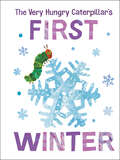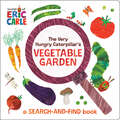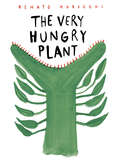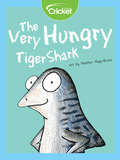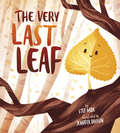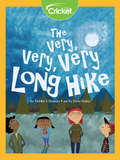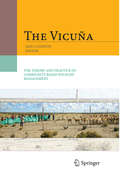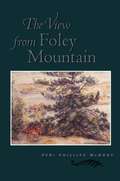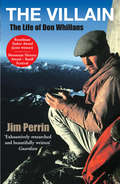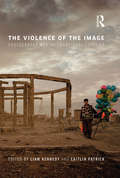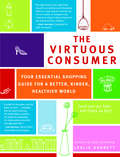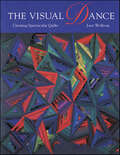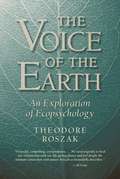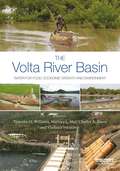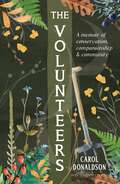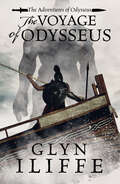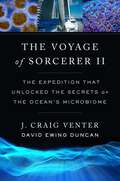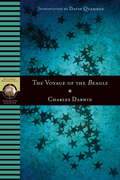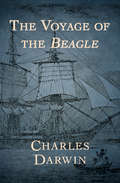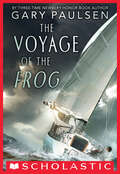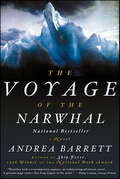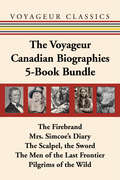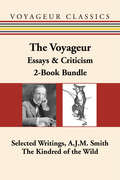- Table View
- List View
The Very Hungry Caterpillar's First Winter (The World of Eric Carle)
by Eric CarleThere are so many ways to spend a chilly winter day. Join The Very Hungry Caterpillar and explore everything winter has to offer!Welcome winter with The Very Hungry Caterpillar and his friends in this sensory exploration of the season. Discover the very best of this time of year: snowy days full of play, the sounds of birds chirping atop a snowman, the smell of cookies fresh from the oven, and so much more!
The Very Hungry Caterpillar's Vegetable Garden: A Search-and-Find Book
by Eric CarleSearch for certain veggies in the vegetable garden with The Very Hungry Caterpillar!In this engaging search-and-find board book, young readers will be challenged to search for various veggies with The Very Hungry Caterpillar. From a bright orange pumpkin to a tiny green pea, tasty snacks are hidden throughout the story for readers—and their favorite caterpillar—to find!
The Very Hungry Plant
by Renato MoriconiOne morning, a beautiful plant sprouts out of the ground, and it is very, very hungry. But water and sunlight aren&’t the only things this plant craves: it&’s a carnivore! The plant gobbles up everything in its path, from caterpillars to geckos to spaceships. But the plant isn&’t the only one who&’s hungry… With humorous nods to Eric Carle, The Very Hungry Plant is another imaginative adventure from the author-illustrator of The Little Barbarian. Playful, energetic paintings and a dash of absurdity create a story sure to spark laughter with every reading.
The Very Hungry Tiger Shark
by Liz HuyckTiger sharks eat almost anything they can catch. But the practice of dumping garbage in oceans is harmful to these predators who tend to eat something without realizing it isn’t food. This causes tiger sharks to eat license plates and other non-food items they cannot digest.
The Very Last Leaf
by Stef WadeLance Cottonwood is the best and brightest of the leaves, but even the top students on the tree have worries. Can Lance conquer his fear of falling and just let go when the time comes for his final exam, or will he let his worries take over? In this funny and encouraging picture book, best-selling author Stef Wade (A Place for Pluto) tells an engaging story and deftly addresses social and emotional struggles many kids encounter each day...feeling anxious, wanting to be perfect, facing fears, etc. These themes combined with illustrator Jennifer Davison's delightful characters and rich autumnal colors make The Very Last Leaf a perfect book for the start of a new school year, the arrival of autumn, or any period of transition in life.
The Very, Very, Very Long Hike
by Debbie UrbanskiA story about two moms and their two children, Edun and Will, going on a hiking and camping trip in the mountains. At first, grump Edun doesn't want to hike, but she comes to love the imagination and wonder of the outdoors. She discovers animal tracks, rocks, and trees, and then takes a drink of water from a glacier.
The Vicuña
by Kristi Anne Stølen Mariela Borgnia Verónica Benítez Jane C. Wheeler Hugo Yacobaccio Jerry Laker Renaudeau d' Arc Nadine Desmond Mcneill Cristian Bonacic Marcelo Cassini Gabriela Lichtenstein Yanina Arzamendia Pete Goddard Bibiana Vilá Jessica Gimpel Ana Wawrzyk Javier García Gomez Iain GordonThe vicuña is one of the few success stories of wildlife conservation. The focus is now shifting from protection to sustainable use. Internationally, policy development has followed the community-based conservation paradigm, which holds that economic benefits from wildlife management practices bring greater commitment on the part of local communities to protect both the species and its habitat. This book takes the position that sustainability is not guaranteed by sustainable use, and that both education and regulation are required to prevent the proliferation of unsustainable practices. The research from the countries presented in this book demonstrate the animal welfare, ecological, economic, social, and conservation trade-offs, which exist between different management systems. This links economics, social and conservation research to provide a unique insight into the viability of community-based wildlife management of a species which until recently was viewed simply as a conservation priority.
The View From Foley Mountain
by Peri Phillips McquayMy feet are practising their steps, gauging the slipperiness of wet lichen on rock and sounding each landing. As my stride shifts to a swing I realize I have a sharper sense of my place in the woods now. I am as taut and limber as a bow-string. I sense bears in the woods, weigh their threat and move on, glorying in the mosses beneath my feet …. We in the woods share fear. By grace of my fear, I am closer to predators and prey. The View From Foley Mountain is a celebration of the joy of living in harmony with the natural world. The seasonal selections lead you through the fields, woods, rock outcroppings and shores of the conservation area which is the author’s home. You will savour the fragrance of maple syrup boiling, share in a summer heron census, snowshoe to a beaver lodge, watch a snapping turtle laying eggs, witness the death of a starving deer, and see turkey vultures soar. Whether she is rejoicing in old barns, canoeing the Snake River, harvesting dye plants or stalking moths at night, Peri Phillips McQuay’s deep love and lyrical vision stimulate you to share her sense of wonder in her surroundings.
The View from Bald Hill: Thirty Years in an Arizona Grassland
by Carl E. Bock Jane H. BockIn 1540 Francisco Vasquez de Coronado introduced the first domestic livestock to the American Southwest. Over the subsequent four centuries, cattle, horses, and sheep have created a massive ecological experiment on these arid grasslands, changing them in ways we can never know with certainty. The Appleton-Whittell Research Ranch in the high desert of southeastern Arizona is an 8,000-acre sanctuary where grazing has been banned since 1968. In this spirited account of thirty years of research at the ranch, Carl and Jane Bock summarize the results of their fieldwork, which was aimed at understanding the dynamics of grasslands in the absence of livestock. The View from Bald Hill provides an intimate look at the natural history of this unique site and illuminates many issues pertaining to the protection and restoration of our nation's grasslands.
The Villain: The Life of Don Whillans
by Jim PerrinDon Whillans has an iconic significance for generations of climbers. His epoch-making first ascent of Annapurna's South Face, achieved with Dougal Haston in 1970, remains one of the most impressive climbs ever made - but behind this and all his other formidable achievements lies a tough, recalcitrant reality: the character of the man himself.Whillans carried within himself a sense of personal invincibility, forceful, direct and uncompromising. It gave him sporting superstar status - the flawed heroism of a Best, a McEnroe, an Ali. In his own circle, his image was the working-class hero on the rock-face, laconic and bellicose, ready to go to war with the elements or with any human who crossed his path on a bad day.
The Violence of the Image: Photography and International Conflict (International Library Of Visual Culture Ser.)
by Liam KennedyPhotography has visualized international relations and conflicts from the midnineteenth century onwards and continues to be an important medium in framing the worlds of distant, suffering others. Although photojournalism has been challenged in recent decades, claims that it is dead are premature. The Violence of the Image examines the roles of image producers and the functions of photographic imagery in the documentation of wars, violent conflicts and human rights issues; tackling controversial ideas such as 'witnessing', the making of appeals based on displays of human suffering and the much-cited concept of 'compassion fatigue'. In the twenty-first century, the advent of digital photography, camera phones and socialmedia platforms has altered the relationship between photographers, the medium and the audience- as well as contributing to an ongoing blurring of the boundaries between news and entertainment and professional and amateur journalism. The Violence of the Image explores how new vernacular and artistic modes of photographic production articulate international friction.This innovative, timely book makes a major contribution to discussions about the power of the image in conflict.
The Virtuous Consumer: Your Essential Shopping Guide for a Better, Kinder, Healthier World
by Leslie GarrettSure, there are people who chain themselves to old-growth trees, raise their one child diaper-free, and make their own soap. The Virtuous Consumer is for the rest of us, struggling to make choices that are better for the planet — and for us. Leslie Garrett has created a comprehensive reference guide that — like a smart, funny, and eco-conscious friend — will steer you toward ethical purchases for everything from lipstick to cars, kids' toys to a new mattress. The Virtuous Consumer is your key to shopping consciously and creating a simpler, greener lifestyle.
The Visual Dance: Creating Spectacular Quilts
by Joen WolfromAn exciting journey into the world of design, The Visual Dance is a presentation of nature's design basics to help you build a foundation for your own style. This inspiring book clearly explains the how-tos of design for quilters and artists alike. Gallery of spectacular quilts, hundreds of detailed drawings, and 11 of Joen's original designs illuminate the discussion. Exercises guide you in understanding and using the design principles.
The Voice of the Earth an Exploration of Ecopsychology (2nd Edition)
by Theodore RoszakExamining perspectives on the connection between man's inner being and the outer world, this title covers topics such as the Anthropic Principle, Gaia Hypothesis, mysticism, religion, nature, and more.
The Volta River Basin: Water for Food, Economic Growth and Environment (Earthscan Series on Major River Basins of the World)
by Vladimir Smakhtin Timothy O. Williams Marloes Mul Charles A. BineyThe Volta River Basin (VRB) is an important transboundary basin in West Africa that covers approximately 410,000 square kilometres across six countries: Benin, Burkina Faso, Côte d’Ivoire, Ghana, Mali and Togo. Its natural resources sustain the livelihoods of its population and contribute to economic development. This book provides a comprehensive, interdisciplinary review and assessment of the issues and challenges faced. The authors provide a science-based assessment of current and future scenarios of water availability, the demands of key sectors, including agriculture and hydropower, and the environment under changing demographic, economic, social and climatic conditions. They also identify solutions and strategies that will allow available water resources to be sustainably used to improve agricultural productivity, food security and economic growth in the VRB. Overall, the work examines from a multidisciplinary and multi-stakeholder perspective the solutions and strategies to improve the use of water and other natural resources in the VRB to achieve enhanced food security, livelihoods and economic growth.
The Voluntary Environmentalists
by Aseem Prakash Matthew PotoskiA novel theoretical framework to analyse the effectiveness of voluntary environmental programs, including ISO 14001.
The Volunteers: A Memoir of Conservation, Companionship and Community
by Carol DonaldsonWhen Carol's world suddenly unravels, she stumbles upon an unexpected opportunity: leading a ragtag team of countryside conservation volunteers. The Volunteers is a heartwarming tale that celebrates the redemptive force of the woods and wildlife, and illustrates how, even in the most unexpected places, we can find a community to call our own.
The Voyage of Odysseus (The Adventures of Odysseus #Vol. 5)
by Glyn IliffeWith the Trojan War over, Odysseus heads home, and the real challenge now begins in this historical adventure by the author of The Oracles of Troy. The armies of Troy have been defeated, and the city lies in ruins. His oath fulfilled, Odysseus can at last sail for Ithaca and the long-awaited reunion with his family. But the gods, who were once his allies, have turned against him. Exiled with the warrior Eperitus, he is thrust into a world of seductive demi-gods and man-eating monsters. As they struggle from one supernatural encounter to another, never knowing what the next landfall will bring, their chances of ever returning home grow fainter. Tensions reach breaking point between Odysseus and his crew. Even the faithful Eperitus&’s loyalties are divided. Eventually only one hope remains. For Odysseus to see his wife and son again, he must tread the paths of the dead and descend into the pits of Hell itself . . . Praise for The Voyage of Odysseus:&“From one adventure to another the pace never lets up. Like Homer&’s original, Glyn Iliffe&’s series is destined to become a classic!&” —Steven McKay, author of the Warrior Druid of Britain series
The Voyage of Sorcerer II: The Expedition That Unlocked the Secrets of the Ocean’s Microbiome
by David Ewing Duncan J. Craig Venter“Will undoubtedly shape our understanding of the global ecosystem for decades to come.”—Siddhartha Mukherjee, author of The Emperor of All MaladiesA celebrated genome scientist sails around the world, collecting tens of millions of marine microbes and revolutionizing our understanding of the microbiome that sustains us.Upon completing his historic work on the Human Genome Project, J. Craig Venter declared that he would sequence the genetic code of all life on earth. Thus began a fifteen-year quest to collect DNA from the world’s oldest and most abundant form of life: microbes. Boarding the Sorcerer II, a 100-foot sailboat turned research vessel, Venter traveled over 65,000 miles around the globe to sample ocean water and the microscopic life within.In The Voyage of Sorcerer II, Venter and science writer David Ewing Duncan tell the remarkable story of these expeditions and of the momentous discoveries that ensued—of plant-like bacteria that get their energy from the sun, proteins that metabolize vast amounts of hydrogen, and microbes whose genes shield them from ultraviolet light. The result was a massive library of millions of unknown genes, thousands of unseen protein families, and new lineages of bacteria that revealed the unimaginable complexity of life on earth. Yet despite this exquisite diversity, Venter encountered sobering reminders of how human activity is disturbing the delicate microbial ecosystem that nurtures life on earth. In the face of unprecedented climate change, Venter and Duncan show how we can harness the microbial genome to develop alternative sources of energy, food, and medicine that might ultimately avert our destruction.A captivating story of exploration and discovery, The Voyage of Sorcerer II restores microbes to their rightful place as crucial partners in our evolutionary past and guides to our future.
The Voyage of the Beagle
by Charles Darwin David QuammenWhen HMS Beagle sailed out of Devonport on 27 December 1831, Charles Darwin was twenty-two and setting off on the voyage of a lifetime. His journal, here reprinted in a shortened form, shows a naturalist making patient observations concerning geology, natural history, people, places and events. Volcanoes in the Galapagos, the Gossamer spider of Patagonia and the Australasian coral reefs - all are to be found in these extraordinary writings. The insights made here were to set in motion the intellectual currents that led to the most controversial book of the Victorian age: The Origin of Species. Includes introduction by David Quammen and notes.
The Voyage of the Beagle: Journal Of Researches Into The Natural History And Geology Of The Countries Visited During The Voyage Of H. M. S. Beagle Round The World
by Charles DarwinThe riveting firsthand account of the historic voyage that led to the theory of evolution When the HMS Beagle set sail in 1831, the science of biology was not far removed from the Dark Ages. When the ship returned to England nearly five years later, Charles Darwin had the makings of a theory that would revolutionize our understanding of the natural world. From volcanoes in the Galapagos to the coral reefs of Australia, The Voyage of the Beagle documents the young naturalist&’s encounters with some of the earth&’s most stunning features. Darwin&’s observations of the people, places, and events he experienced make for compelling reading and offer a fascinating window into the intellectual development of his ideas about natural selection. A brilliant travelogue and a revealing glimpse into the Victorian mindset, The Voyage of the Beagle is an indispensable companion volume to On the Origin of Species. This ebook has been professionally proofread to ensure accuracy and readability on all devices.
The Voyage of the Frog (Piper Ser.)
by Gary PaulsenAn adventure novel about survival at sea from the Newbery Award–winning author of Northwind. “An epic, often lyrical journey of self-discovery.” —Kirkus Reviews (starred review)ALA/YALSA Best Book for Young Adults ALA Notable Book for ChildrenALA/YALSA Quick Pick for Reluctant Young Adult ReadersDavid thought he was alone, that the ocean around him was all there was of the world. The wind screamed, the waves towered, and his boat, the twenty-two foot fiberglass FROG, skidded and bucked and, each moment, filled deeper and grew heavier with sea water.David thought surely he was dead at fourteen. His uncle Owen, who had taught him about sailing safely, would be so angry. Owen had died only days ago, his last wish for David to take the FROG out on his own, and sail her beyond sight of the coast, and once there, scatter Owen’s ashes.David had done this the evening before, but he hadn’t thought of a storm roaring across the Pacific, or of the terror of being alone later in the dark hundreds of miles from home with no radio or flares and little food. He hadn’t thought of a shark attacking, or of the four killer whales, or the oil tanker large as a city about to sink him and the FROG . . . But in fact, David wasn’t alone at all. He’d had the FROG as a partner from the first—his uncle’s guiding spirit. He had only to learn that.“Paulsen’s spare prose offers an affecting blend of the boy’s inner thoughts and keen observations of the power of nature to destroy and to heal.” —School Library Journal
The Voyage of the Narwhal: A Novel
by Andrea Barrett"A glistening narrative, crammed full of rich, pictorial description and tingling suspense." —Michiko Kakutani, New York Times Book Review An intoxicating story of the thrills of exploration, the fallacy of discovery, and the inevitable costs of ambition from the "genius enchantress" (Karen Russell) author of Ship Fever, winner of the National Book Award.The Narwhal has a simple mission: to find the remains—human and material—of a disappeared ship. But its rash and obsessive young commander, Zeke Voorhees, has ulterior motives that may spell doom for the Narwhal and its crew. His soon-to-be brother-in-law, scholar-naturalist Erasmus Darwin Wells, may be the only one aboard who can alter their fate. Back in Philadelphia, the women left behind make journeys of the imagination as they await the Narwhal’s return. Wielding her signature lyrical and precise style, Andrea Barrett unravels the mid-nineteenth-century American romance with the Arctic in a "genuine page turner that long lingers in the mind" (Philip Graham, Chicago Tribune).
The Voyageur Canadian Biographies 5-Book Bundle: The Firebrand / Mrs. Simcoe's Diary / The Scalpel, the Sword / The Men of the Last Frontier / Pilgrims of the Wild
by Julie Allan Grey Owl Michael Gnarowski James Polk William Kilbourn Ronald Stagg Mary Quayle Innis Elizabeth Posthuma Simcoe Hugh Eayrs Norman Bethune Allan Susan Ostrovsky Sydney GordonVoyageur Classics is a series of special versions of Canadian classics, with added material and new introductory notes. In this bundle we find five biographical and autobiographical titles that shed light on some of Canada’s most important figures at crucial times in the country’s development. William Kilbourn brings to life the rebel Canadian hero William Lyon Mackenzie: able political editor, first mayor of Toronto, and the gadfly of the House of Assembly. The Scalpel, the Sword celebrates the turbulent career of Dr. Norman Bethune, a brilliant surgeon, campaigner for socialized medicine, and communist. Elizabeth Simcoe’s diary, describing Canada from 1791 to 1796, is history written as it was being made, an account instilled with excitement and delight. And finally, two titles by the legendary Grey Owl tell his own astonishing story and advocate for a closeness with and respect for nature. Each of these books is an essential classic of Canadian literature. Includes The Firebrand Mrs. Simcoe’s Diary The Scalpel, the Sword The Men of the Last Frontier Pilgrims of the Wild
The Voyageur Canadian Essays & Criticism 2-Book Bundle: Selected Writings, A.J.M. Smith / The Kindred of the Wild
by Michael Gnarowski Charles G. Roberts James Polk A.J.M. SmithVoyageur Classics is a series of new versions of Canadian classics, with added material and special introductions. In this bundle we find two classic works of the art of the Canadian essay. Charles G.D. Roberts was a distinguished writer of his time who published more than forty volumes of poetry, romance fiction, and nature writing – making him one of the most popular writers of his time. He pioneered the animal story in which he went beyond surface elements of nature and endowed his animal "characters" with qualities of feeling and intelligence that brought them closer to their human cousins. Roberts’ career as a writer transcended his Canadian roots and he was internationally known and popular in America and England. Arthur James Marshall Smith – prize-winning poet, essayist, influential anthologist, and critic – died in 1980. His last book, The Classic Shade: Selected Poems, on which Selected Writings is based, stands as his final intention in the world of literature. To this long out of print book the editor has added original material by Smith in which he defined and advanced modernism in Canadian writing. Includes Selected Writings, A.J.M. Smith The Kindred of the Wild
